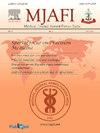双相多检测器计算机断层血管造影对紫绀型先天性心脏病患儿肺动脉及侧支血管的评价
Q2 Medicine
引用次数: 0
摘要
本研究的目的是比较双期多探头计算机断层血管造影(CTA)与经胸超声心动图(TTE)和心导管血管造影(CCA)对青紫型先天性心脏病患儿肺动脉及侧支血管、主动脉-肺侧支动脉(MAPCAs)的评估效果。方法采用前瞻性观察研究方法,纳入32例紫绀型先天性心脏病(CCHD)患儿(男18例,女14例,年龄2 ~ 116月龄)。所有患者均行TTE、CTA和CCA。将CTA评价肺动脉和MAPCAs的结果与TTE进行比较,并与CCA结果进行相关性分析。结果所有的CTA检查都是充分的,除了一个(3.1%)的病例,在三种方式中任何一种都没有显示肺动脉主动脉和左肺动脉。4例(12.6%)在CCA上右肺动脉解剖不清楚或未显示,而CTA在这些病例中能够显示肺动脉。有11例(34.3%)不能清晰显示一条或多条肺动脉。肺动脉直径良好的病例(对应Z评分在1 ~ 2之间)有统计学意义(P <;0.001)肺动脉直径、McGoon比率、Nakata指数和在所有三种模式下计算的肺动脉z评分之间存在相关性。CTA和CCA对MAPCAs和动脉导管未闭(PDA)的评估一致,而TTE未能显示6例(18.8%)MAPCAs。结论cta对肺动脉和MAPCAs的评价优于TTE和CCA。CTA在检测心外异常方面也优于TTE。本文章由计算机程序翻译,如有差异,请以英文原文为准。
Dual phase multidetector computed tomography angiography in evaluation of pulmonary arteries and collateral vessels in children with cyanotic congenital heart diseases
Background
The purpose of this paper is to compare the efficacy of dual-phase multidetector computed tomography angiography (CTA) with transthoracic echocardiogram (TTE) and cardiac catheterization angiography (CCA) in evaluation of pulmonary arteries and collateral vessels, major aortopulmonary collateral arteries (MAPCAs) in children with cyanotic congenital heart diseases.
Methods
The study was a prospective observational study where 32 pediatric patients (18 males, 14 females and age range 2–116 months) with cyanotic congenital heart diseases (CCHD) were included. All patients underwent TTE, CTA, and CCA. The findings of CTA in evaluation of pulmonary arteries and MAPCAs were compared with TTE and correlated with CCA findings.
Results
All CTA studies were adequate except in one (3.1%) case in which main pulmonary artery and left pulmonary artery were not visualized on any of the three modalities. Right pulmonary artery anatomy was not clear or not demonstrated in four cases (12.6%) on CCA, whereas CTA was able to demonstrate pulmonary arteries in these cases. TTE was inadequate in 11 cases (34.3 %) in which one or more pulmonary artery was not clearly visualized. In cases with good pulmonary artery diameter (corresponding to Z score between 1 to 2) statistically significant (P < 0.001) correlation was found between pulmonary artery diameters, McGoon ratio, Nakata index, and Z-scores calculated for pulmonary arteries on all three modalities. There was concordance between CTA and CCA in assessment of MAPCAs and patent ductus arteriosus (PDA), whereas TTE failed to demonstrate MAPCAs in six cases (18.8%).
Conclusion
CTA was found to be superior to TTE and CCA for the assessment of pulmonary arteries and MAPCAs. CTA is also superior to TTE in the detection of extracardiac anomalies.
求助全文
通过发布文献求助,成功后即可免费获取论文全文。
去求助
来源期刊

Medical Journal Armed Forces India
Medicine-Medicine (all)
CiteScore
3.40
自引率
0.00%
发文量
206
期刊介绍:
This journal was conceived in 1945 as the Journal of Indian Army Medical Corps. Col DR Thapar was the first Editor who published it on behalf of Lt. Gen Gordon Wilson, the then Director of Medical Services in India. Over the years the journal has achieved various milestones. Presently it is published in Vancouver style, printed on offset, and has a distribution exceeding 5000 per issue. It is published in January, April, July and October each year.
 求助内容:
求助内容: 应助结果提醒方式:
应助结果提醒方式:


